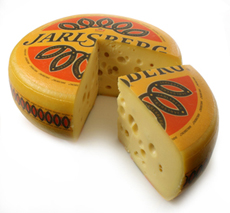TIP OF THE DAY: Jarlsberg Cheese From Norway

[1] Jarlsberg from Norway: the top special cheese in the U.S. [2] Jarlsberg Cheese Crisps in four flavors: Chipotle, Garlic & Herb, Mediterranean Sea Salt and Rosemary & Olive Oil. We’ve been enjoying them plain, with soup and salads, and with dips. [3] “What big eyes you have,” said Goldilocks to the Jarlsberg. Eyes is the industry term for what consumers call holes (photos courtesy Jarlsberg). |
Sixty years ago, a group of students and scientists at the Agricultural University of Norway decided to explore old legends and cheese-making traditions, and to create an old cheese with modern cheese-making technology.
The origin of the modern cheese they created traces back to the early 1800s when Swiss cheese makers came to southern Norway to teach Norwegians how to make cheese. Norwegians began to produce their own cheese similar to Swiss cheese, but after the departure of the Swiss, the particular style did not endure. Fast forward: 1956 arrives, along with the students who had a project under the direction of their professor, Ole Martin Ystgaard of the Dairy Institute at the Agricultural University of Norway. Their project: to revive an old-style cheese. They studied ancient texts and recipes, experimented, and created a wonderful cheese they named Jarlsberg® (pronounced YAHRLS-berg). It was named after Count Vadel Jarlsberg, whose countship was created in 1673. His estate was located near where the earlier version of the cheese was first produced. A mild, semisoft, part skim, pasteurized cheese made from cow’s milk, Jarlsberg has been beloved from the beginning for its mild, sweet and nutty taste and the appeal of its large round holes (eyes). It is Norway’s most famous edible export, the #1 cheese imported to the U.S., and the #1 specialty cheese* brand in the U.S. As a bonus to millions of Americans, it’s also lactose-free†. Bravo, Professor Ystgaard and team. Who wouldn’t love bragging rights to this creation: for oneself and for generations to come! Jarlsberg is one of the most versatile cheeses. More than a table cheese and sandwich cheese, it can be: †Cheddar and authentic Parmigiano-Reggiano are the other two cheeses that are 100% lactose free. |
|
|
THE EYES HAVE IT
Each of the world’s cheeses is made from a specific recipe, which includes both the type(s) of cheese cultures and the production techniques. Both combine to deliver each cheese’s unique flavor, aroma and appearance. Jarlsberg enchants not only with its flavor, but with its eyes. Emmental, the first cheese with large eyes, is what Americans think of as Swiss cheese—although there are more than a dozen different types of Swiss cheese, including Appenzeller, Raclette, Gruyère, Tête de Moine, Tilsit and Vacherin Mont d’Or. (Emmental, Gruyère and Vacherin Mont d’Or are also made in France.) Some Swiss have eyes, some don’t. Some people find Jarlsberg similar to French Gruyère, which has holes. Modern-style Swiss Gruyère does not. The larger the holes, the more mature the cheese. The U.S. Department of Agriculture has a stipulation that the “eyes” in “grade-A Swiss” can be no larger than 13/16 of an inch in diameter. Why? Because larger eyes can make the cheese difficult to slice on modern cheese-slicing equipment. The blades were catching on the large holes and shredding the cheese rather than slicing it. The holes in cheese are a deliberate byproduct‡ of fermentation, the process by which milk is turned into the curds that are used to create cheese. They are the result of propioni bacteria, which cause gas to expand within the curd and create the holes’ The longer cheese ages, the bigger the holes get, and the more intense flavor is developed. Head to Jarlsberg.com for dozens of new and familiar recipes, such as: |
[3] Jarlsberg Eggs Benedict. [4] A Croque Monasieur sandwich made with Jarlsberg instead of Gruyere (photos courtesy Jarlsberg). |
|
|
________________ |
||



